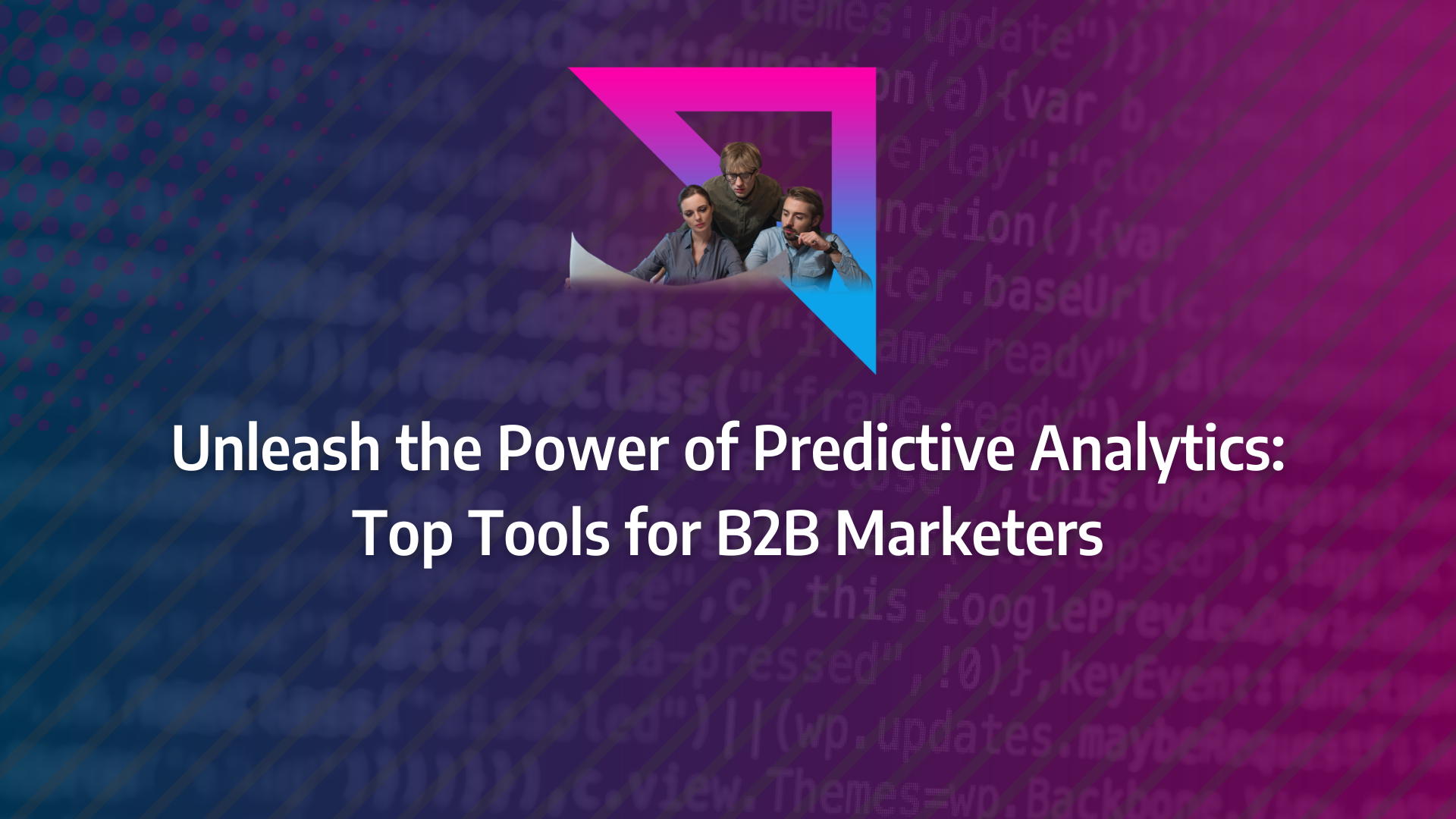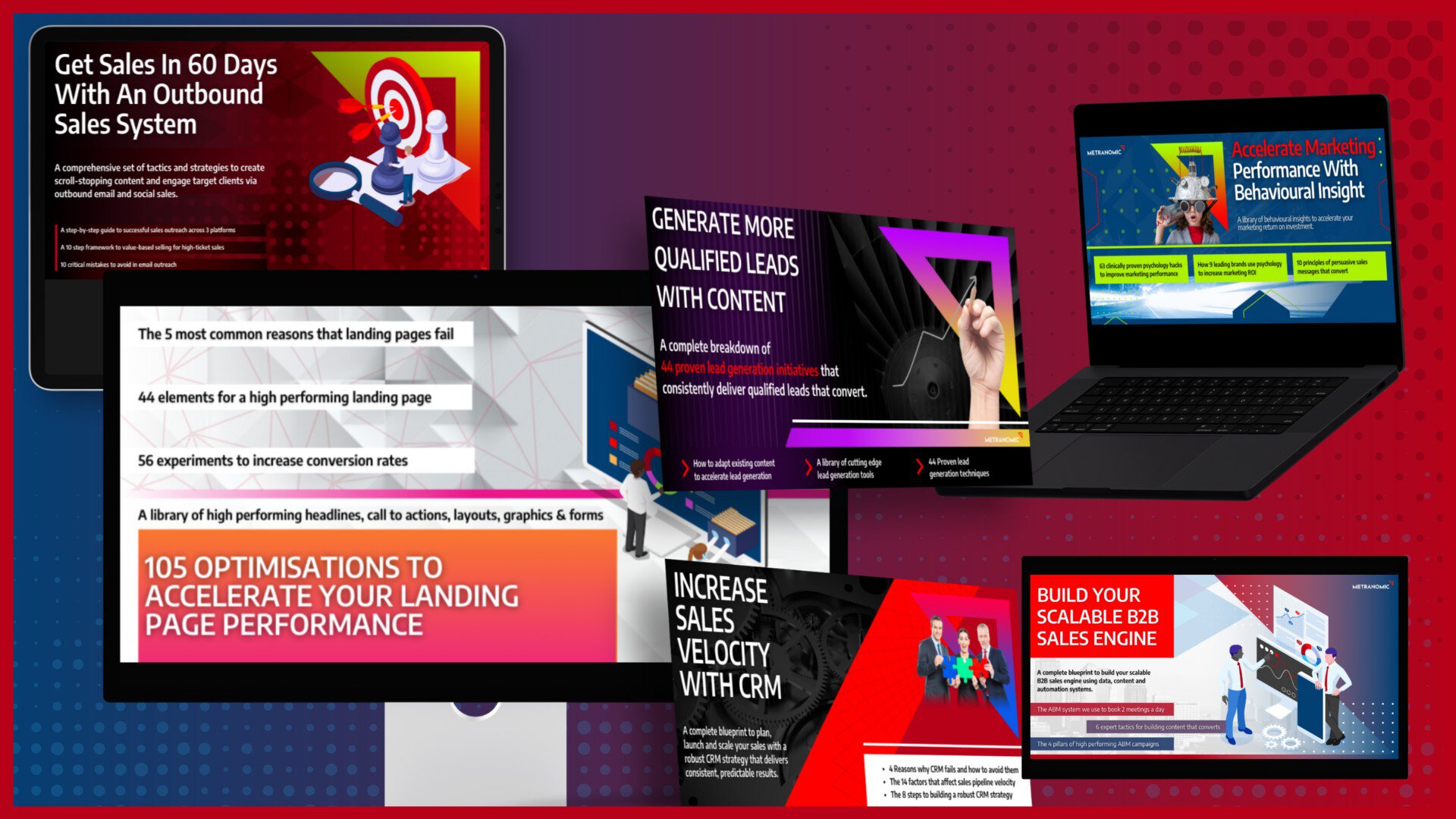As the market becomes increasingly competitive, the need for accurate predictions and effective strategies has never been greater. Predictive analytics tools offer a powerful solution, transforming raw data into actionable insights that can guide your marketing efforts to success.
Imagine having the ability to anticipate customer behaviour, optimise your campaigns in real-time, and maximise your ROI—all with the help of sophisticated tools designed to simplify complex data. This guide will take you step-by-step through the top predictive analytics tools available to B2B marketers, empowering you to harness the full potential of your data.
- Harness Predictive Analytics: Leverage predictive analytics tools to anticipate customer behaviour and enhance your marketing strategies with data-driven insights.
- Optimise Campaigns: Use real-time data to fine-tune your marketing campaigns, ensuring they are responsive to customer needs and market changes.
- Maximise ROI: Implement predictive analytics to increase your return on investment by targeting the right audience with the right message at the right time.
- Simplify Data Complexity: Choose tools that turn complex data into understandable insights, making it easier to make informed decisions.
- Stay Competitive: Keep ahead of competitors by adopting predictive analytics, ensuring your marketing strategies are always one step ahead.
How do tools for predictive analytics help businesses make data-driven decisions?
Predictive analytics offers a multitude of use cases, each designed to optimise business processes and drive growth. Here are some key applications where predictive analytics can make a significant impact:
- Enhancing operational efficiency: By identifying bottlenecks and inefficiencies, businesses can streamline processes, saving time and resources.
- Mitigating external risks: Predictive analytics can help identify potential threats, allowing companies to take proactive measures to reduce exposure.
- Reducing customer churn: By analysing customer behaviour, businesses can pinpoint at-risk customers and implement retention strategies.
- Improving customer experience: Predictive insights can guide personalisation efforts, enhancing overall customer satisfaction.
- Determining optimal pricing strategies: Predictive models can forecast how price changes might affect demand, aiding in pricing decisions.
- Forecasting sales: Businesses can use predictive analytics to anticipate sales trends, enabling better inventory management and sales strategies.
- Strategic team growth: Predictive models can help in planning for future workforce needs, ensuring the business scales effectively.
To fully leverage these advantages, it is crucial to select the right predictive analytics tools and ensure their predictive analytics models are properly trained. Fortunately, the range of available predictive software is expanding, offering options from established players like IBM and Oracle to innovative startups.
Key Features to Consider in Predictive Analytics Tools
As the market for predictive analytics tools continues to grow, catering to an increasing number of industries and niches, it is essential not to assume that all predictive analysis tools are created equal. Each tool may cater to different segments, and understanding the key features to look for is vital in making an informed choice.
- Data Modelling Capabilities: The approach to data modelling varies across predictive analytics tools, with techniques ranging from classification and regression models to time series analysis and Bayesian inference. Understanding the data modelling methodologies employed by a tool is crucial to ensure it aligns with your business needs.
- Machine Learning Integration: Top predictive analytics tools leverage machine learning to process and analyse vast datasets. The type of machine learning models used can significantly influence the accuracy and relevance of the predictions, so it’s important to understand how these models are implemented.
- User-Friendliness: A tool’s ease of use is paramount, especially if it will be used by multiple team members. An intuitive interface that requires minimal training can lead to broader adoption across the organisation, maximising the tool’s impact.
- Integration Capabilities: Seamless integration with existing platforms is essential for maintaining up-to-date data inputs. Predictive analytics tools that easily connect with your current systems ensure the data remains relevant and accurate, which is critical for reliable predictions.
- Scalability: As your business grows, so too will the complexity and volume of data you manage. The predictive analytics platform you choose must be able to scale in tandem with your business, accommodating increased data volumes, more users, and more complex models.
Predictive analytics tools have become essential for businesses aiming to harness the power of data-driven decision-making. These tools empower organisations to forecast trends, identify risks, and uncover new opportunities within their data. As demand for these insights grows, a wide array of predictive analytics tools has emerged, each offering distinct features and capabilities.
For data analysts and business intelligence professionals, selecting the most suitable predictive analytics tool is crucial for extracting meaningful insights and driving strategic initiatives. This overview has explored some of the leading predictive analytics tools available today, highlighting their key features, strengths, and potential applications across various industries. By understanding the diverse offerings in this rapidly evolving field, professionals can make informed decisions that align with their specific analytical needs and organisational goals.
What Matters Most?
From our experience, understanding the core problem before selecting predictive analytics tools significantly enhances effectiveness. Clients often discover that fostering collaboration between data scientists and domain experts ensures insights align closely with business goals. Moreover, we typically emphasise continuous learning within teams; staying abreast of evolving tools not only keeps skills sharp but also drives innovation in predictive strategies.Get In Touch
What features should I look for in a tool for predictive analytics?
Predictive analytics tools have become indispensable assets for businesses aiming to leverage the full potential of data-driven decision-making. These advanced platforms are designed with a suite of features that enable companies to uncover intricate patterns, anticipate trends, and derive actionable insights. A fundamental characteristic of top-tier predictive analytics tools is their seamless integration with a wide array of data sources. This capability allows analysts to synthesise structured and unstructured data from multiple channels, thereby constructing a holistic view of the business landscape.
The usability of predictive analytics tools is another crucial factor. Leading platforms often feature intuitive interfaces, including drag-and-drop functionality, which empowers business analysts to develop complex predictive analytics models without requiring deep coding expertise. This ease of use is complemented by advanced visualisation capabilities, enabling users to present their findings in clear and compelling formats. Additionally, many predictive analytics tools are equipped with machine learning algorithms that evolve with the influx of new data, ensuring that the insights generated remain current and precise over time.
Core Functionalities of Predictive Analytics Software
Predictive analytics software is designed to offer robust functionalities that help businesses extract meaningful insights from their data. At the heart of these tools is the ability to create comprehensive datasets, which facilitate the generation of detailed personas and support in-depth analysis. Advanced features extend to multi-product or project search queries, which enable cross-dataset exploration and the discovery of hidden trends and patterns.
The use of visual experiences, such as journey maps, significantly enhances the analytical process by converting raw data into actionable insights. For example, in the context of a banking client, analysts can use predictive analytics software to generate process maps and derive recommendations based on existing data. These tools are often tailored with sector-specific templates, streamlining the analytical process across different industries. By capitalising on these core functionalities, businesses can make informed, data-driven decisions, optimise their processes, and secure a competitive advantage in their respective markets.
Integration Capabilities and Compatibility
In the world of predictive analytics tools, the ability to integrate smoothly with existing systems and maintain compatibility with various platforms is of paramount importance. Leading solutions provide seamless integration with a diverse range of data sources, including spreadsheets, databases, and third-party applications. This flexibility enhances the richness and accuracy of the predictions by allowing analysts to incorporate a wide variety of datasets into their analysis.
Moreover, compatibility with different programming languages and platforms is a critical consideration when selecting predictive analytics tools. Advanced solutions often support multiple languages such as Python, R, and SQL, enabling data scientists to operate within their preferred environments. The capability to export results in various formats and to integrate with visualisation tools further empowers teams to communicate insights effectively across the organisation, thus fostering a culture of data-driven decision-making at every level.
Can tools for predictive analytics be integrated with other data analysis platforms?
In today’s competitive landscape, data-driven insights have become invaluable in understanding customer behaviour, preferences, and trends before they even fully materialise. By leveraging b2b predictive analytics, businesses can anticipate market shifts, fine-tune their offerings, and ensure that every aspect of their operations is optimised for success. Data doesn’t just show you where you’ve been; it illuminates the path forward, helping you distinguish between the areas that are driving success and those that are draining resources. Predictive risk analytics further enhance this capability by identifying potential risks long before they manifest, allowing businesses to navigate challenges with confidence and precision.
Unlocking Business Potential with BI Predictive Analytics
BI predictive analytics delves deep into your data—whether it’s sales figures, customer behaviour, or market trends—to uncover patterns and insights that might otherwise go unnoticed. It doesn’t just provide a retrospective view; it leverages AI algorithms, statistical models, and machine learning to make informed predictions about future scenarios. This enables businesses to anticipate everything from sales trends and customer demand to operational challenges.
For instance, if you manage an online store, BI predictive analytics can analyse your past sales data, consider seasonal trends, and predict which products are likely to become your next bestsellers. Similarly, it can assess customer data to forecast who is likely to become a loyal customer and who might be at risk of churn.
With these forward-looking insights, businesses can make smarter, more strategic decisions today. Whether it’s refining your marketing strategy, optimising inventory levels, or enhancing customer service, b2b predictive analytics tools equip you with the foresight needed to stay ahead of the curve.
Source: McKinsey
The Role of Predictive Analytics in Business Intelligence
Business intelligence (BI) serves as the bedrock of understanding what is happening in your business right now, pulling together data from every corner of your operations—sales, customer interactions, supply chain, and more—and presenting it in an easily digestible format. It’s like a dashboard that offers a comprehensive snapshot of your business’s health at a glance.
While BI tells you what has happened and what is currently happening, predictive analytics takes this a step further by forecasting what could happen next. By applying statistical algorithms and machine learning to your BI data, predictive analytics identifies patterns and trends that suggest future outcomes. Together, BI and predictive analytics create a powerful synergy, enabling you to make more informed, strategic decisions.
Consider the example of a retailer. BI might reveal which products are currently top sellers and highlight periods when sales typically spike. Predictive analytics builds on this information, forecasting future sales trends and helping you determine which inventory to stock up on and when to schedule your marketing campaigns.
Optimising Business Processes with BI-Driven Predictive Models
Consider running a manufacturing plant. Traditionally, decision-making might have been a blend of experience, intuition, and basic data analysis. However, with the advent of BI-driven predictive models, this approach has evolved dramatically, propelling businesses into a new era of operational excellence.
BI tools gather and analyse data across your entire operation—from production lines to supply chain logistics—providing a comprehensive view of how processes are performing down to the finest details. This rich dataset is a goldmine, and when combined with predictive analytics models, it becomes a powerful tool for forecasting and optimising every aspect of your business.
For example, a predictive analytics model might highlight that a specific machine is likely to fail within the next month, based on patterns and trends identified in its operational data. Armed with this foresight, you can schedule pre-emptive maintenance, avoiding costly downtime and ensuring that your production continues smoothly.
In inventory management, BI-driven predictive models analyse sales trends, seasonal fluctuations, and supply chain variables to precisely forecast the stock levels required and when. This precision reduces the risk of overstocking, which can tie up valuable capital, or understocking, which could lead to missed sales opportunities.
These models also extend their utility to customer service, predicting buying behaviours or identifying customers who are at risk of churning. With these insights, you can tailor your marketing efforts or customer service strategies to keep your customers engaged and loyal, enhancing overall satisfaction and retention.
Top Predictive Analytics Tools
Evaluating the top predictive analytics tools involves deploying innovative methods to see how each transforms raw data into actionable strategic insights. By leveraging advanced algorithms and machine learning, these tools empower businesses to predict patterns and make data-informed decisions, thereby optimising processes and improving customer interactions. Below is a closer look at some of the leading tools in this space, underscoring their critical role in driving success across various industries.

Neo4j Graph Data Science
Overview
Neo4j Graph Data Science is specifically designed to harness data relationships, offering superior projections and insights. It stands out as one of the best tools for predictive analysis within the realms of data science and machine learning. Utilising the structural advantages of graph databases, it enables data scientists to swiftly comprehend complex relationships and uncover hidden patterns. This powerful engine facilitates the seamless integration of data science initiatives into business ecosystems, accelerating their transition from development to production.
Why Choose Neo4j Graph Data Science?
- Prioritises data relationships, going beyond traditional analytics to deliver deeper insights and improved predictability.
- Ensures smooth interaction with existing data ecosystems, speeding up project implementation and value extraction.
- Features a comprehensive suite of over 65 optimised graph algorithms for effective, large-scale data analysis, enhancing strategic decision-making.
- Focuses on context-first analysis, offering profound insights across various business processes and applications, making it ideal for anomaly detection, recommendation engines, and other specialised uses.
Board
Overview
Board is utilised by more than 2,000 enterprises worldwide as a leading provider of intelligent planning solutions, demonstrating the advantages of predictive analytics tools. What makes Board unique is its ability to combine strategy, finance, and operations into a single, integrated planning approach, enabling businesses to manage performance more effectively. From budgeting and financial consolidation to performance and strategy management, Board offers a consolidated view of organisational performance, significantly enhancing decision-making capabilities. Global giants like Coca-Cola, BASF, Toyota, and H&M have successfully transformed their planning processes with Board, proving its capacity to deliver actionable insights and drive corporate success.
What Sets Board Apart?
- Provides integrated solutions for budgeting, planning, forecasting, financial consolidation, and more.
- Offers a unified view of performance across various planning processes, enhancing strategic decision-making.
- Delivers data-driven insights that inform decisions and drive business success.
- Operates in over 25 countries, with implementations in over 100, ensuring global reach and support.
- Proven success across diverse industries, highlighting its effectiveness in driving business value.
Our Tactical Recommendations
Clients often discover the importance of regularly updating predictive models with fresh data, allowing them to stay relevant in fast-changing markets. We also recommend utilising advanced visualisation tools; clear communication of predictive insights fosters better understanding and engagement among stakeholders, ensuring that data-driven decisions resonate across the organisation.Get In Touch
What role do machine learning algorithms play in predictive analytics tools?
Machine learning plays a pivotal role in the functionality and efficacy of predictive analytics tools, enabling businesses to harness vast amounts of data to make informed decisions. But what exactly is machine learning?
Understanding Machine Learning
Machine learning is a specialised subset of artificial intelligence (AI) that utilises algorithms to process and analyse large datasets. Unlike traditional programming, where a computer follows explicitly coded instructions, machine learning allows computers to “learn” from data by identifying patterns and relationships. This enables the system to make predictions or decisions without direct human intervention, continually improving as more data is introduced.
Through the development of algorithms and models, machine learning systems can analyse data, recognise patterns, and build mathematical models based on those patterns. These models can then be used to make predictions, test hypotheses, and provide comprehensive insights into unseen or future data. This capability makes machine learning indispensable in enhancing the depth and accuracy of data analysis, particularly within the realm of b2b predictive analytics.
Key Types of Machine Learning Algorithms
There are three primary types of machine learning algorithms that are commonly used within predictive analytics models:
- Supervised Learning: This method involves training a model using labelled data, where the desired output is known. The algorithm learns from these examples to make accurate predictions on new, unlabelled data.
- Unsupervised Learning: Unlike supervised learning, unsupervised learning does not rely on labelled data. Instead, the algorithm identifies patterns, similarities, or groupings within the data without predefined outcomes.
- Reinforcement Learning: This approach involves training an agent to interact with an environment, learning from the feedback it receives. Over time, the algorithm adapts its decision-making strategy to improve performance.
Machine learning has rapidly become integral to many organisations’ data analysis processes, significantly enhancing their ability to test hypotheses and make data-driven decisions with greater confidence and precision.
The Integral Role of Machine Learning in Data Analysis
Data analysts and machine learning engineers work in tandem, albeit with distinct objectives. While data analysts focus on interpreting and understanding data to derive actionable insights, machine learning engineers concentrate on developing algorithms and models that can autonomously process and analyse data. This collaboration is crucial in maximising the potential of predictive analytics tools within b2b environments.
Machine learning enhances the data analysis process in several key ways:
- Pattern Recognition: Machine learning algorithms assist data analysts by recognising patterns within increasingly large and complex datasets. Through techniques such as data exploration, visualisation, and mining, machine learning ensures a more comprehensive understanding of underlying trends.
- Predictive Analytics: Machine learning models can be trained to make highly accurate predictions based on historical data. These models enable businesses to forecast future trends, mitigate risks, and make proactive, informed decisions.
- Automation of Data Processing: Machine learning automates repetitive tasks such as data cleaning, preprocessing, and manipulation. This automation makes the data analysis process more efficient, allowing professionals to focus on interpreting and deepening their understanding of the data.
- Anomaly Detection: An essential step in data analysis is ensuring the data is free from anomalies, errors, or outliers. Machine learning algorithms excel at detecting and correcting these issues, which is particularly valuable in areas like fraud detection and identifying abnormal patterns in consumer behaviour.
- Enhanced Data Visualisation: Machine learning can be integrated with data visualisation tools, providing dynamic and interactive representations of data that enhance the communication of findings.
- Data Segmentation: Machine learning is often employed to segment data into specific groups based on identified patterns. These segments can be used to deliver more personalised experiences, optimise marketing strategies, and improve product offerings.







